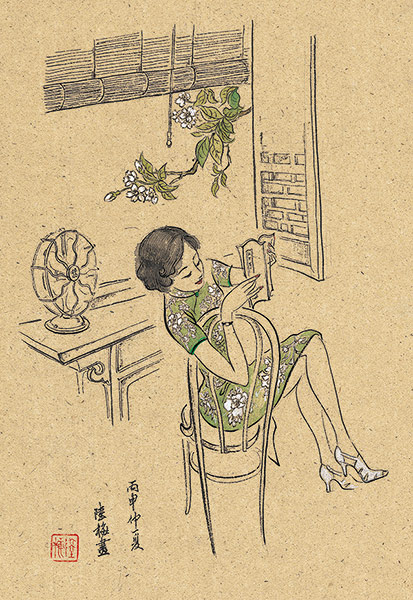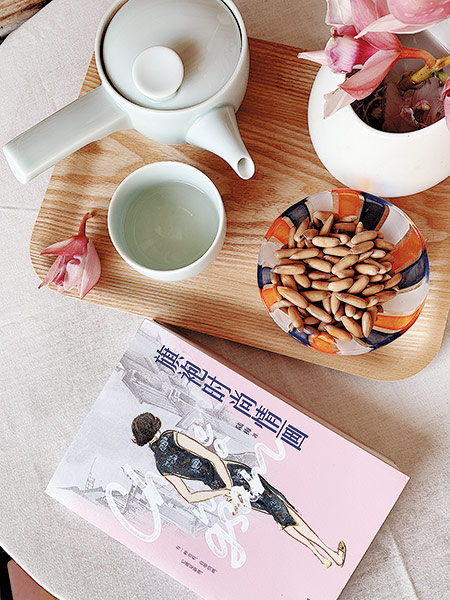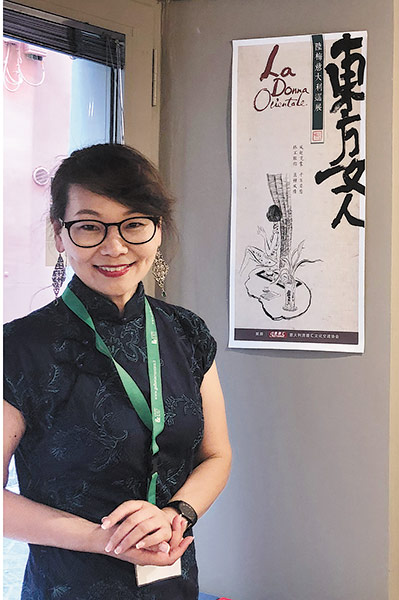
A painting by Lu Mei portray woman in cheongsam, exuding an air of ease and contentment. [Photo provided to China Daily]
Among traditional and folk attire, a dress with a history of 100 years-the cheongsam-has become an icon, representative of the glamour and elegance of Chinese women.
Illustrator and designer Lu Mei, fascinated by the appeal of the dress, has been creating paintings centered on a woman in cheongsam, quite often portraying the subject lounging about, a book or teacup in hand, exuding an air of ease and contentment.
Her recent book, Cheongsam, compiles illustrations, delineating the dress' transformation in accordance with history, and reflects on the modern mindset of associating the dress with a romanticized lifestyle from early last century.
Lu's interest in the garment and the consequential creations have to do with her admiration of writer Eileen Chang. In 2007, when she was asked to draw the illustrations for a book focusing on Chang and the clothing she wrote about, Lu accepted the offer and started her research on the dress.

A painting by Lu Mei portray woman in cheongsam, exuding an air of ease and contentment. [Photo provided to China Daily]
Today's typical image of the dress, also known as qipao, often involves a mandarin collar, a slim cut and a high split. But with her illustrations, Lu demonstrates that when the dress first came into being in the late 1910s, it resembled the robes worn by men of the time, featuring a wide cut and long length.
"The unusually perceptive Eileen Chang wrote that in 1920, women from the entire nation decided to don cheongsam, literally meaning long robe, because women intended to imitate men. They felt defeated by the unequal treatment of women and decided to boycott all female characteristics," Lu says.
"This can be interpreted as the pursuit of freedom and equality of women from early last century."
The transformation of cheongsam was closely connected with social prosperity and stability. In the 1930s, those making the dress adopted narrower cuts, shorter sleeves and higher splits that accentuated the female figure, and the textures and styles diversified.

Illustrator and designer Lu Mei traces the transformation of cheongsam, an iconic dress of Chinese women, in her new book. [Photo provided to China Daily]
Lu says a trend this century has made cheongsam a fashion choice for women and an emblem of Chinese traditional culture once again, but today's image of the dress is different from the original, mostly based on style ideas from the 2000 film In the Mood for Love, where the dress is shown as extremely closefitting, only to exaggerate visual aesthetics.
Lu also delves into the cheongsam's cultural connotations, as well as the fashion and lifestyle it reflects.
She says, perhaps because of its exquisiteness and elegance, cheongsam is now often associated with a yearning among urban dwellers for a slow-paced life. "It provides an emotional outlet for our nostalgia. The dress offers the easiest way for us to slow down our pace and soothe our souls. It's more than just attire. It's a sense of belonging and culture."
However, in her everyday life, she does not usually wear it. Instead of donning the dress, Lu advocates to her readers to learn more from the feminist concepts that emerged in China early last century-to be independent, to keep on learning and to develop a healthy beauty standard.

Illustrator and designer Lu Mei traces the transformation of cheongsam, an iconic dress of Chinese women, in her new book. [Photo provided to China Daily]
"Life should be realized, not idealized. I try to devote my time to things I am interested in, and maintain my curiosity and motivation," Lu says.
Her illustrations have been featured in many books, including some by Zhang Xin, president of Guangzhou Writers Association, who commends her drawings as simplistic yet vivid, able to capture feminine beauty with just a few strokes.
"In this era of competition and pursuit of success, we have become accustomed to always being in a race, interacting with others on a superficial level and making profit-driven decisions," Zhang writes in the preface of Lu's book.
"Our understanding of slow pace and beauty remains merely conceptual. This is where Lu Mei and her paintings prove their value."

